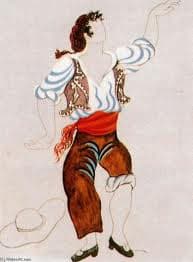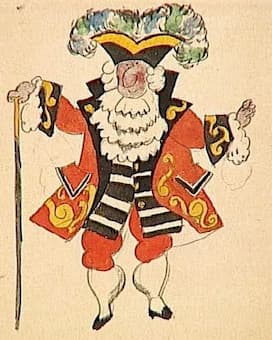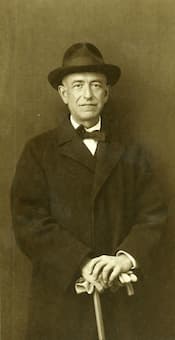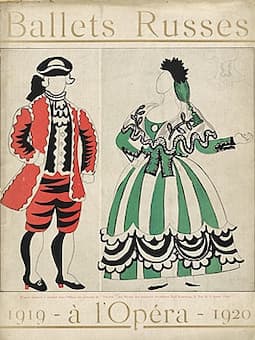
Serge Diaghilev
On 22 July 1919, the Alhambra Theatre in London saw the world premiere of the ballet El sombrero de tres picos under the title “Le Tricorne.” It had been commissioned by Serge Diaghilev and featured choreography by Léonide Massine, costumes and décor by Pablo Picasso, and music by Manuel de Falla. The origins of this work date back to 1916 when Manuel de Falla composed the music for a modest pantomime called El Corregidor y la molinera (The magistrate and the miller’s wife) based on a novel by Pedro Antonio de Alarcón. It is a juicy and complicated story, but essentially, the bumbling village magistrate whose uniform includes a traditional tricorne hat, tries to seduce the miller’s wife. The magistrate has the miller arrested on trumped up charges, inadvertently falls in the river, and jumps into the Miller’s bed. Clothes are exchanged, which results in mixed up identities and competing seductions. In the end, virtue triumphs and the magistrate is publically humiliated. The pantomime was immediately successful, and during its initial runs, Serge Diaghilev and his Russian Ballet, alongside Igor Stravinsky, happened to be in Madrid. Diaghilev had been asking Falla to write something for his ballet troupe for years, and he now asked the composer to transform the pantomime into a full ballet, expanded and rescored for a large orchestra.
Manuel de Falla: El sombrero de 3 picos (The 3 Cornered Hat) – Suite No. 1 (Württembergische Philharmonie Reutlingen; Salvador Mas-Conde, cond.)

Félix Fernández García
Diaghilev put together an extraordinary cast of characters, and in preparation for producing Spanish choreography he enlisted the services of dancer Félix Fernández García, a phenomenal performer “he had found in a working-class café in the back streets of Madrid.” García accompanied Diaghilev, Massine and de Falla on a tour of Spain in July 1917, and introduced them to dancers and performances in Zaragoza, Toledo, Salamanca, Burgos, Sevilla, Córdoba, and Granada. Massine took flamenco lessons from García, and he also joined the company as the star of the new ballet. Massine, Picasso, and de Falla worked separately on the choreography, sets/costumes, and the music for the ballet over subsequent months.

The Three-Cornered Hat
Picasso designed sets and costumes that were characteristically witty and brilliant, and he “devised a front drop curtain depicting a bullfight in ochre, pale pine, white, blue, and gray that was so magnificent that Falla wrote some new music at the last minute just to show it off.” Sadly, shortly before the London premiere García fell ill and Massine had to take over his role. On the afternoon of the first performance, Falla was called home to Granada to his mother’s deathbed, and Ernest Ansermet stepped in to conduct. The Three-Cornered Hat was hugely successful and quickly became an international hit. Massine later explained, “of his more than one hundred ballets, it was the one of which he was most proud.” Misia Sert, with Rubinstein playing the piano, hosted the post-premiere party and “Picasso drew a laurel crown on the composer’s bald head with his hostess’s eyebrow pencil.”
Manuel de Falla: El sombrero de tres picos (The Three-Cornered Hat) – Suite No. 2 (New York Philharmonic Orchestra; Dimitri Mitropoulos, cond.)

Manuel de Falla
Falla extracted two suites for orchestra from the ballet, one from each act, by removing some vocal and transitional passages. Suite No. 1 opens with a short fanfare that accompanies the rising of the curtain. People are milling around as warm and sleepy “Afternoon.” The miller, who severely dislikes the magistrate, instructs his wife to dance a seductive “Fandango” to lure him in. The miller’s wife teases the magistrate with an offer of “Grapes,” and then runs away. When the magistrate runs after her, he is led into an ambush and the angry husband frightens the clownish magistrate away with a stick.

Picasso’s costume design for Le Tricorne
Suite No. 2 opens with “The Neighbor’s Dance,” a seguidillas danced by the villagers. Massine recalled his performance of the second number, “The Miller’s Dance.” “I began stamping my feet repeatedly and twirling my hands over my head. As the music quickened I did a series of high jumps, ending with a turn in mid-air and a savage stamp of the foot as I landed. The mental image of an enraged bull going into the attack unleashed some inner force, which generated power within me. For one moment it seemed as if some other person within me was performing the dance.” The “Finale” abounds with mistaken identities and general confusion, but all ends well with the miller and his wife reunited. In conclusion, the villagers join in the “Jota,” a wild celebratory dance from Aragon.
For more of the best in classical music, sign up to our E-Newsletter
Manuel de Falla: El Sombrero des Tres Picos
